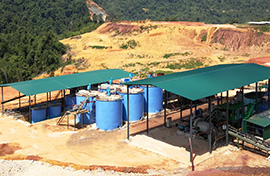-
 E-mail
guhaixin0724@gmail.com
E-mail
guhaixin0724@gmail.com
-
 Call Us
008613683147042
Call Us
008613683147042
 E-mail
guhaixin0724@gmail.com
E-mail
guhaixin0724@gmail.com
 Call Us
008613683147042
Call Us
008613683147042
 Home
Guides
Leaching Reagent Guide
How to Extract Refractory Gold Ore Using Gold Recovery Cyanide Process?
Home
Guides
Leaching Reagent Guide
How to Extract Refractory Gold Ore Using Gold Recovery Cyanide Process?
2019-11-29 Views: 4600
Warm Tip: If you want to know more information, like quotation, products, solutions, etc., please Click here ,and contact us online.

Gold recovery cyanide process is widely used. A professional gold recovery industry that handles high-sulfur, high-arsenic, and other refactory gold concentrates, the arsenic grade is about 10%. The high-sulfur and high-arsenic gold concentrate is pretreated by two-stage roasting, and the two-stage roasting sand is leached into the gold recovery cyanide process by sulfuric acid leaching. Due to the high impurity content of such refactory gold concentrates, after two stages of roasting and acid leaching, the acid leaching slag and acid pickling liquid still have high impurity contents, which brings great difficulties to the production of the gold recovery cyanide process. It is difficult to optimize the indicators and control costs.
After years of exploration and rich gold recovery cyanide process experience accumulated over the years. This gold recovery industry transformed some measures and made the main technology index and cost consumption greatly optimized. Such as equipment replacement, enhanced pickling countercurrent washing, reducing acid pickling residue water, fine control of cyanide leaching conditions, optimization of replacement system control, and strengthening of cyanide countercurrent washing.
At the national academic conference on new technologies and products for gold (non-ferrous metal) mining, David, the mine's chief engineer, described such a case and analyzed the optimization of the gold recovery cyanide process for refactory gold mines. It became a guideline for the refactory gold ore dressing plant that using gold recovery cyanide process.
In the process of the gold recovery cyanide process, when the acid leaching residue and the pickling liquid have a high impurity content, such as the use of lime as the protective alkali in the gold recovery cyanide leaching process, the consumption is large. The large amount of calcium ions accumulated in the gold recovery cyanide system caused serious crystallization and scaling of the equipment and pipelines, and even caused the continuous and stable operation of the gold recovery cyanide process. Under comprehensive consideration, the use of solid sodium hydroxide can be used as a protective base during gold recovery cyanide leaching process.
After the underflow solid-liquid separation equipment of the pickling thickener was replaced with a KS5-45 full-automatic ceramic filter, the moisture of the pickling residue was controlled, and the labor intensity and operating cost were greatly reduced.
In terms of optimizing the control of the gold recovery cyanide process, measures include strengthening the pickling countercurrent washing, reducing the pickling residue moisture, finely controlling the leaching conditions, optimizing the replacement system control and increasing the cyanide countercurrent washing rate. The higher the moisture content of the pickling residue, the more the total amount of impurities entering the gold recovery cyanide process. In order to minimize the moisture of pickling residue, the main measures adopted in gold recovery cyanide process are:
1.Control Slurry Concentration
Control the concentration of the slurry entering the pickling ceramic filter at about 45%. When the concentration of the slurry is low, use the thickener to reflux to ensure that the concentration of the ceramic filter is in operation.
2.Using Backwash Gas System
Changing the backwash water of the ceramic filter to backwash gas can not only ensure the backwash pressure of about 0.1MPa, but also reduce the consumption of the filter element.
3.Regularly Immerse Ceramic Plate With Lye
Regularly immerse the ceramic plate with lye to improve the suction effect of the ceramic plate, while greatly reducing the consumption of the ceramic plate, and saving more than $75,000 in ceramic plate consumption costs.
The engineer said that the fine control of gold recovery cyanide process conditions is directly related to the leaching rate of gold, the cost of leaching, and whether the production of gold recovery cyanide process is stable and healthy, especially the leaching pH, cyanide concentration, cyanide leaching concentration and oxygen supply is most critical control conditions during the gold recovery cyanide process.
In gold recovery cyanide process, when the concentration of leaching cyanide is controlled at 1500 mg / L to 1800 mg / L, the cyanide concentration of noble liquid is 1000 mg / L to 1200 mg / L, and the pH value is about 10, which is good for zinc powder of gold replacement. In order to achieve such an index, the engineer David said that the detection accuracy can be improved by standardizing the detection method for gold in lean liquids; zinc powder replacement posts can adjust the zinc powder addition speed in time based on the test results. Through the exploration of many years of production practice, the main technical indicators of the gold recovery cyanide process have been optimized year by year, and the consumption of main materials has been reduced year by year.
Due to the use of lime as a protective alkali in the design, the gold recovery cyanide process has been changed to sodium hydroxide according to the actual situation, and the unit consumption of sodium hydroxide per ton of ore has generally declined. The unit consumption per ton of sodium cyanide and zinc powder has been significantly better than the designed value.
No. 188, Xinhai Street, high-tech Industrial Park, Fushan District, Yantai, Shandong, China.

Please leave your message here! We will send detail technical info and quotation to you!